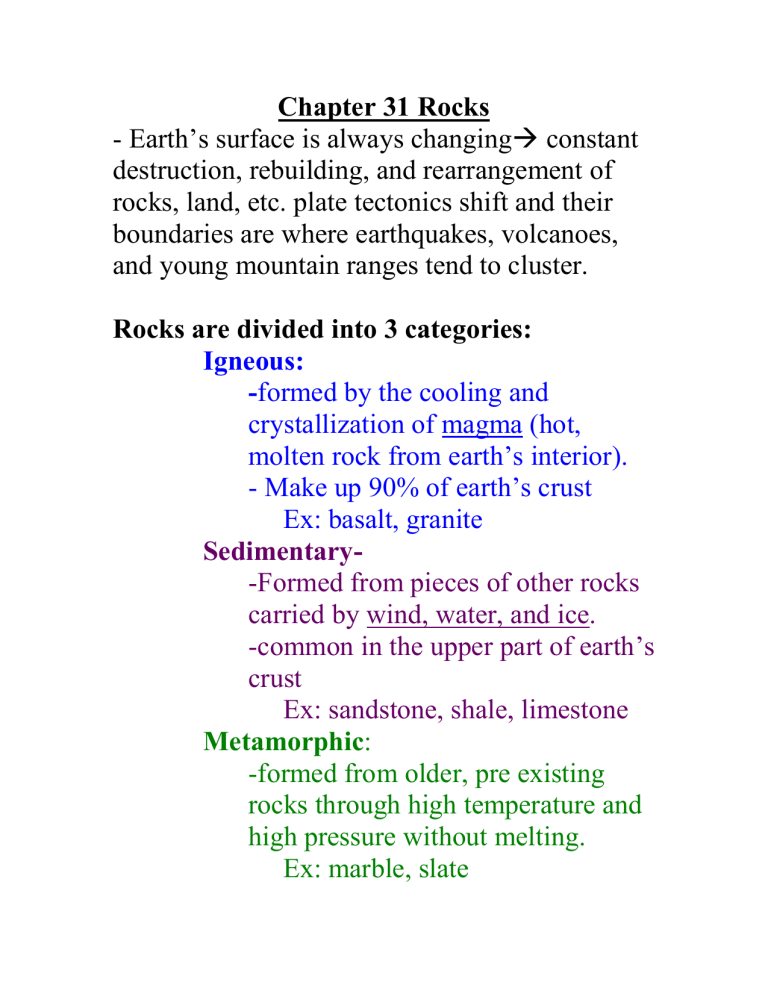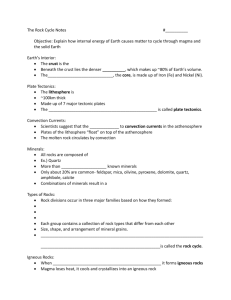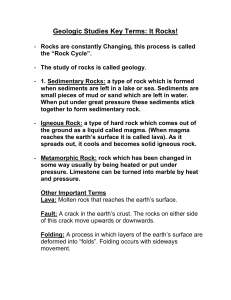Ch - Images

Chapter 31 Rocks
- Earth’s surface is always changing
constant destruction, rebuilding, and rearrangement of rocks, land, etc. plate tectonics shift and their boundaries are where earthquakes, volcanoes, and young mountain ranges tend to cluster.
Rocks are divided into 3 categories:
Igneous:
formed by the cooling and crystallization of magma (hot, molten rock from earth’s interior).
- Make up 90% of earth’s crust
Ex: basalt, granite
Sedimentary-
-Formed from pieces of other rocks carried by wind, water, and ice.
-common in the upper part of earth’s crust
Ex: sandstone, shale, limestone
Metamorphic :
-formed from older, pre existing rocks through high temperature and high pressure without melting.
Ex: marble, slate
IGNEOUS ROCK
Continents= granite, andesite
Ocean floor= basalt
Form at earth’s surface
(extrusive) or below (intrusive)
Igneous Rocks form at the Earth’s surface
partial melting and crystallization result in different types of magma
Higher silicon= slow flow viscosity
Lower silicon= fast flow ex: basaltic magma
magma comes up through the earth’s surface
lava
lava gets pushed through cracks/ fissures in the Earth’s crust or through a central vent
lava from fissures more common than volcanic explosions (central vent)
Fissure Eruptions Occur Under Water and
Land
fast flowing lava (basaltic) erupts at the bottom of the ocean floor
occur on land flood basalts create flood plains
Volcanoes come in a variety of shapes and sizes:
Shield o Steady supply of basalt lava o Create broad, gently sweeping slopes o Lava pours out in all directions
Cinder Cones o Very steep; not higher than 300 meters o Form from the piling of ash, cinders and rock exploded from a single vent
steep-sided cone
Composite Cones (strata cone) o Eruption= lava, ash, mud in alternating layers o Steep- sided summit plus gently sloping lower areas o Explosive eruptions o Magmas + lavas don’t flow very easily o Thick magma traps gas
Higher Temp + Higher Pressure= explosion
Some Igneous Rocks form Beneath Earth’s
Surface
Intrusive: igneous rocks that form beneath earth’s Surface
plutons: large igneous rock bodies occur in a variety of shapes and sizes, slabs, blobs, etc.
Plutons
Dike
Intrusion of magma into fractures that cut across the layers of existing rock; old channel ways for rising magma; often occur near volcanic vents.
Batholith
Largest pluton; made by numerous intrusive events; forms the cones of many major mountain systems; constantly pushed up while erosion continues to wear it down.
Sill
Intrusion of magma into fractures parallel to the layering of existing rock.
Lacolith
A body of rock created when slow moving, less fluid magma rises up in the earth’s crust and spread into a mushroom shape; they push layers into dome shape.
Sedimentary Rocks Blanket Most of the Earth’s Surface
most common in the uppermost part of the crust
they form a “blanket” over igneous and metamorphic rocks; cover 2/3 earth’s surface
remains of older rocks
Volcanism
generates new rock material
Weathering
breaks rock down; rock is eroded
Weathering
Chemical:
Reactions that involve water
decomposes rock into smaller pieces
Mechanical:
Breaks rocks down physically into smaller pieces
Erosion: the process by which weathered rocks and rock particles are removed and transported away (by wind, water, ice, etc.)
Sediments composed of small fragments of other rocks are called clastic sediments.
1.
start jagged/ angular
2.
during transport they collide and break
3.
decrease in size and become more rounded
4.
when transport stops, deposition and sedimentation begin
Deposition
when transport stops, the particles are deposited (deposition)
-the larger the sediment particle, the stronger the water current must be to move it
.: heavier/larger particles get deposited first, smaller particles grains stay in the water flow, and are carried by the current
*water currents are the strongest next to the source of the current
Sedimentation
sediment particles are deposited one layer at a time in a horizontal manner;
Sediments turn into rock
Compaction
Weight of layers press layers together
Cementation:
Dissolved compounds
(silicon dioxide, calcium carbonate, iron oxide) act as a “glue” to hold particles and layers together.
Well-sorted deposit = particles settle and have similar size
Poorly-sorted deposit = particle size varies
-Therefore poorly-sorted deposit/angular particles= sediment traveled short distance
- well-sorted deposit/ rounded particles=sediment traveled a long distance
Glacial movement water movement wind movement
Poorly-sorted angular/jagged particles well-sorted fine
Clastic Sediments are Classified by particle size- 3 most abundant sedimentary rocks:
1.
shale
2.
sandstone
3.
conglomerate
Shale
made of very small particles
deposited in quiet waters: lake, pond, delta, flood plain
color: gray, black, red, brown, green
Organic matter swampy, no oxygen
Sandstone (made of 3 different minerals)
1) Quartz= “ quartz sandstone” – well-sorted, well rounded particles
2) Feldspar = “arkose” – poorly-sorted, not well rounded particle
3) Quartz and feldspar and rock fragments= graywack
-forms in variety of environments: beaches, dunes, marine sandbars, river channels, land and underwater canyons
Conglomerate: made of gravels and well rounded rock fragments
(large particles)
Large particles= carried by strong currents
Rounded edges= traveled far
Found in river channels, rapidly eroding coastlines
Metamorphic Rocks Are Changed Rocks
All rocks can undergo metamorphism.
It takes place if rocks are heated or compressed for a very long time. Ex: pottery
Clay + Heat = Ceramic
Limestone
Marble
Shale
Slate
Rocks can be stretched and compressed.
During metamorphism, no minerals melt.
Change occurs through recrystallization of pre-existing minerals and by the mechanical deformation of rock.
Metamorphic rocks are associated with mountains/mountain-building.
Recrystallization:
Minerals from the rock change from high temperatures and high pressure.
Mechanical Deformation:
Rock is subjected to physical stress and may/may not involve high temps; occurs deep in the
Earth’s crust.
There are 2 types of metamorphism: Regional & Contact:
Contact:
Body of rock is intruded by magma
High temp. makes a
“zone of alteration” that surrounds the intrusion.
Alteration is greatest at the contact
The altered width can be a few cm to several meters
Grain size changes due to recrystallization
(grain size largest at contact & decrease with distance from that point)
Water content changes at contact,
-where temp is high, the water content is low; resulting minerals like the garnet which is formed in high temp/dry environments
-farther away from the contact = waterrich, low temp minerals like muscovite
Regional:
Caused from physical stress and heat over a large region such as in mountain building where the earth’s crust is severely compressed; zones tend to be broad and extensive.
Metamorphic rocks are defined by:
1) their appearance
2) the minerals they contain
For classification and identification, they are divided into two groups: Foliated and Nonfoliated
Foliated
Contain mica
Have a “layered” appearance
Minerals realign into parallel planes
(perpendicular to the compression)
Not layered like sediment, it’s more like sheets
Common are:
SLATE- low temp and pressure, very fine grained, excellent cleavage, can be split into thin slabs ex: pool tables, chalkboards, roof tiles
SCHIST- shiny, form under high temp. and pressure, can see their minerals ex: biotite
GNEISS altering layers of dark, platy minerals and light granular minerals (striped), formed from a higher temp. than gneiss ex: quartz and feldspar
Nonfoliated
Can form in areas of high temp. and pressure
Needs the right combination of mica and platy minerals to foliate.
If contact is not hot enough, no foliation
MARBLE coarse-grained, crystalline, metamorphosed limestone
QUARTZITE metamorphosed quartz stone








